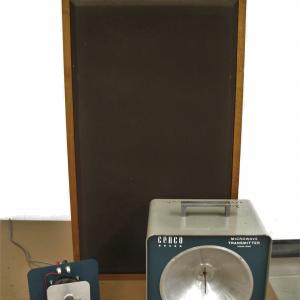College of Liberal Arts & Sciences
5N10.65 - Antennas
Connect the power supply to the transmitter and attach the antenna. Insert the antenna into the bulb receiver unit. Turn on the transmitter and bring the receiver close to the transmitter so that the antenna of both units are parallel. As the light bulb comes on, tune the receiver antenna to maximum reception. If the transmitter is set between two parallel walls the unit will set up standing waves that can be detected with the receiver. The most nodes that I have ever detected is 6 in LR I going from the lecture bench to the back of the room.
This demo will also show polarization characteristics. Find a node that lights the bulb brightly. Turn the receiver antenna from parallel to perpendicular and the light will go out. Turn back to parallel and it will come back on.
This unit does interfere with and can do damage to the lecture room microphones so be sure that they are turned off when you operate the demo. Also, only operate the unit when demonstrating as there is the possibility of interruption of other radio transmission within a block of the transmitter.
One variation of this is to replace the small light bulb and antenna receiver with a 6" fluorescent tube. When brought close to the middle or ends of the transmitting antennas the tube will light up brightly.
Connect the receiver to the amplifier. This will make the reception audible. The characteristics of a dipole transmitter and receiver can be explored.
- Gregory A. DiLisi, Alison Chaney, Kenneth Kane, C. S. C. KG8DN, Robert A. Leskovec, K8DTS, "The Lady Be Good: A Case Study in Radio Frequency Direction Finders", TPT, Vol. 59, #3, March 2021, p. 172.
- Johanna L. Miller, "A Nonreciprocal Antenna Speaks Without Listening", Physics Today, Vol. 69, #5, May 2016, p. 14.
- Robert Ehrlich, "O.7. Transverse Nature of Radio Waves", Turning the World Inside Out and 174 Other Simple Physics Demonstrations, p. 175 - 176.
Disclaimer: These demonstrations are provided only for illustrative use by persons affiliated with The University of Iowa and only under the direction of a trained instructor or physicist. The University of Iowa is not responsible for demonstrations performed by those using their own equipment or who choose to use this reference material for their own purpose. The demonstrations included here are within the public domain and can be found in materials contained in libraries, bookstores, and through electronic sources. Performing all or any portion of any of these demonstrations, with or without revisions not depicted here entails inherent risks. These risks include, without limitation, bodily injury (and possibly death), including risks to health that may be temporary or permanent and that may exacerbate a pre-existing medical condition; and property loss or damage. Anyone performing any part of these demonstrations, even with revisions, knowingly and voluntarily assumes all risks associated with them.
